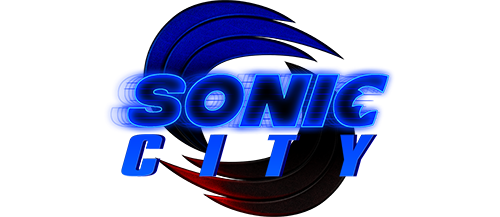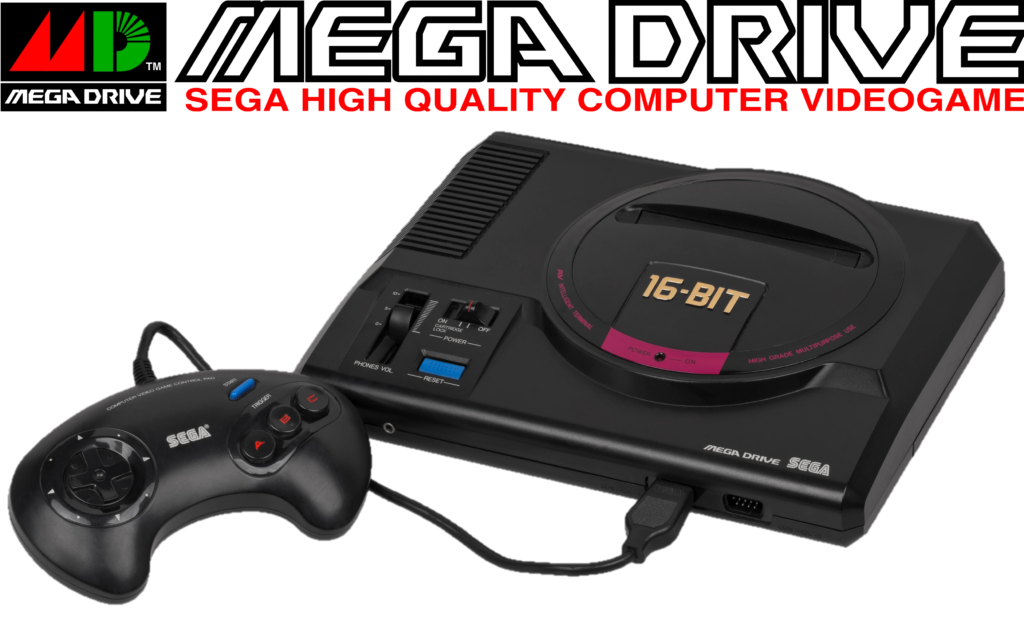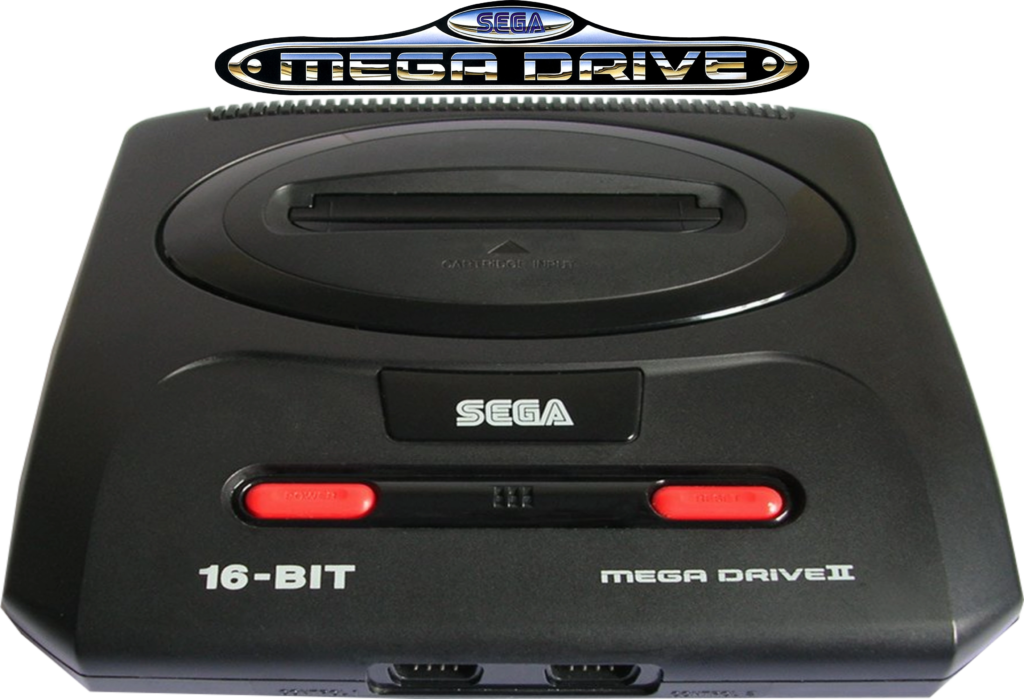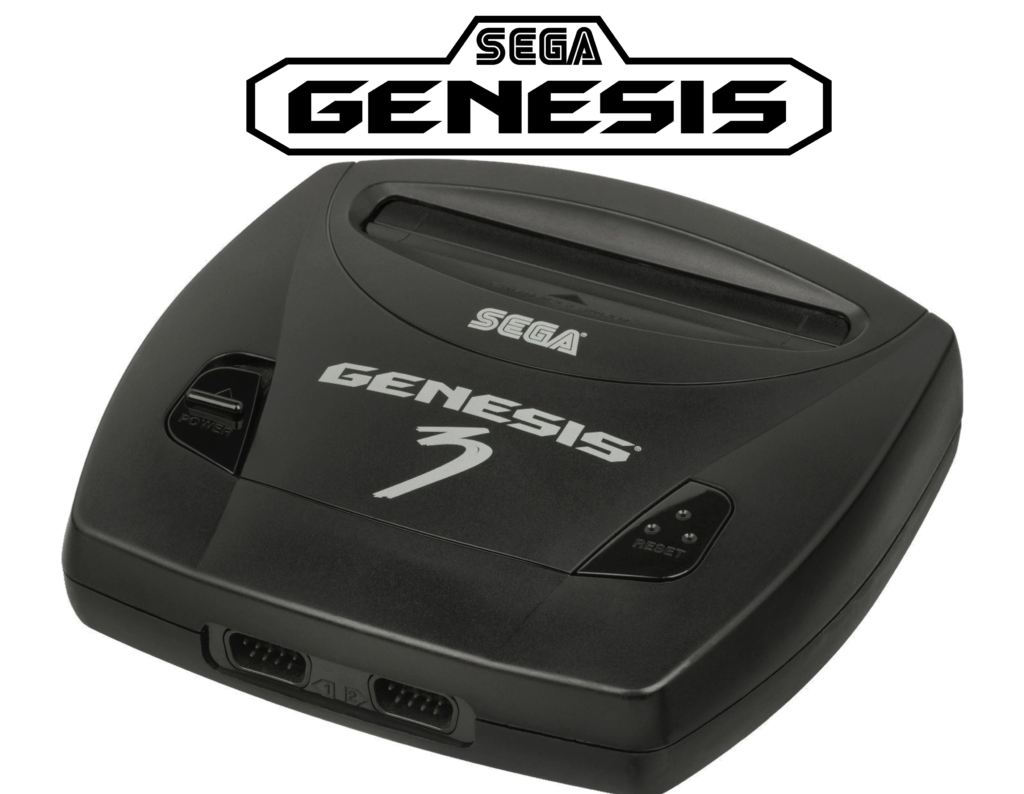SEGA Mega Drive
The Sega Mega Drive[note 1]Japanese: メガドライブ, Hepburn: Mega Doraibu, known as the Sega Genesis in North America, is a 16-bit fourth-generation home video game console developed and sold by Sega. It was Sega’s third console and the successor to the Master System. The console was released in 1988 in Japan as the Mega Drive and in 1989 in North America as the Genesis. In 1990, it was distributed as the Mega Drive by Virgin Mastertronic in Europe, Ozisoft in Australasia, and Tectoy in Brazil. In South Korea, it was distributed by Samsung Electronics as the Super Gam*Boy and later the Super Aladdin Boy.[note 2]Super Gam*Boy (Korean: 수퍼겜보이; RR: Syupeo Gem Boi), Super Aladdin Boy (Korean: 수퍼알라딘보이; RR: Syupeo Alladin Boi)
The Genesis was designed by an R&D team supervised by Hideki Sato and Masami Ishikawa. It was adapted from Sega’s System 16 arcade board and centered on a Motorola 68000 processor as the CPU, a Zilog Z80 as a sound controller, and a video system supporting hardware sprites, tiles, and scrolling. The console plays a library of more than 900 games on ROM-based cartridges, and several add-ons were released, including a Power Base Converter to play Master System games. Sega created two network services to support the Genesis: Sega Meganet and Sega Channel.
Despite its poor performance in Japan against its main competitors, Nintendo’s Super Famicom and NEC’s PC Engine, the Mega Drive achieved considerable success in North America, Brazil, and Europe. This success was attributed to its library of arcade game ports, the popularity of Sega’s Sonic the Hedgehog series, several popular sports franchises, and aggressive youth marketing that positioned it as the cool console for adolescents. The 1991 North American release of the Super Nintendo Entertainment System triggered a fierce battle for market share in the United States and Europe known as the “console war”. This drew significant attention to the video game industry, and the Genesis and several of its games attracted legal scrutiny on matters involving reverse engineering and video game violence. Controversy surrounding violent games such as Night Trap and Mortal Kombat led Sega to create the Videogame Rating Council, a predecessor to the Entertainment Software Rating Board.
In total, 30.75 million first-party Genesis units were sold worldwide. Tectoy sold an estimated 3 million licensed variants in Brazil, Majesco projected it would sell 1.5 million licensed variants of the system in the United States, and smaller numbers were sold by Samsung in South Korea. By the mid-2010s, licensed third-party Genesis rereleases were still being sold by AtGames in North America and Europe. Many games have been re-released in compilations or on online services such as the Nintendo Virtual Console, Xbox Live Arcade, PlayStation Network, and Steam.
The Mega Drive/Genesis is remembered as Sega’s most successful console before the company’s transition from the hardware market to third-party development in the early 2000s following the commercial failure of the Dreamcast. The console was succeeded by the Sega Saturn in 1994. Eleven Sonic games were released for this system, all of which have been ported to later compilations such as Sonic Mega Collection and Sonic Mega Collection Plus.
Sega Mega Drive
General Information
Type
Video game console
Manufacturer(s)
- Sega
- Tectoy (BR)
- Majesco (Model 3)
- Samsung (KOR)
- AtGames (Plug And Play)
First Available
Model 1:
JP 29 October 1988[1]Gallery (Japanese). Sega. Retrieved on 25 February 2022.
NA August 1989[2]Kent, Steven L. (2001). The Ultimate History of Video Games. Roseville, California: Prima Publishing. pp. 404–405. ISBN 0-7615-3643-4.
EU September 1990[3]Kent, Steven L. (2001). The Ultimate History of Video Games. Roseville, California: Prima Publishing. pp. 404–405. ISBN 0-7615-3643-4.
BR Late 1990[4]Tecblogger (17 September 2010). Tectoy History (Portuguese). Tectoy. Archived from the original on 23 March 2012. Retrieved on 26 February 2022.
Model 2:
JP 23 April 1993
NA June 1993
EU August 1993[5]“Letter“. Sega Force Mega: 19. November 1993. Archived from the original. Retrieved on 25 February 2022.
Model 3:
USA 1998
Also Known As
Launch Price
- ¥21000 (JP)
- ¥12800[6]Mega Drive 2 (Japanese). Sega. Retrieved on 25 February 2022. (JP, Model 2)
- $189.99 (US)
- $49.95 (US, Model 3)
- £189.99 (UK)[7]Sega Mega Drive/Genesis Console Information. Console Database. Base Media. Retrieved on 4 June 2018.
Discontinued
- 1997
- 1999 (Majesco)
Units Sold
- 30.75 million
- 3 million (Tectoy)
- 1.5 million (Majesco, projected)
Technical Information
CPU
- Motorola 68000 (primary)
- Zilog Z80 (secondary)
RAM
- 72kB RAM
- 64kB VRAM
Sound
Model 1 & 2:
- Yamaha YM2612
- Texas Instruments SN76489
- Stereoscopic audio
Model 3:
- Yamaha YM2612
- Texas Instruments SN76489
- Monophonic audio
Tectoy & AtGames revisions:
- Yamaha YM2612
- Texas Instruments SN76489
- Monophonic audio (Tectoy)
- Stereoscopic audio (AtGames)
History
Development
Although the Sega Master System found relative success in Europe and later in Brazil, it failed to gain much traction in North America or Japan, where the market was dominated by Nintendo’s Nintendo Entertainment System/Famicom by the mid-to-late 1980s.[8]Kent, Steven L. (2001). The Ultimate History of Video Games: The Story Behind the Craze that Touched our Lives and Changed the World. Roseville, California: Prima Publishing. pp. 303, 360. ISBN 0-7615-3643-4.[9]Nintendo Official Magazine Staff (2001). Nintendo Official Magazine – Nintendo’s Market Share 1988. Future Publishing. pp. 35.[10]Business Week staff (1999). Business Week – Nintendo’s Market Share 1990. pp. 60. Sega, seeking to become a stronger competitor, decided to develop a new console. Initially considered the MK-1601, the console was eventually named the “Sega Mega Drive,” symbolizing superiority and speed, particularly with its powerful Motorola 68000 processor. Due to a trademark dispute, the North American version was named the “Genesis.”
In the early 1980s, Sega Enterprises, Inc., a subsidiary of Gulf+Western, was a leading arcade game manufacturer in the United States, with revenues surpassing $200 million between July 1981 and June 1982.[11]Brandt, Richard; Gross, Neil (February 21, 1994). “Sega!”. BusinessWeek. Bloomberg L.P. Archived from the original on December 3, 2013. Retrieved October 10, 2013. However, a downturn in the arcade business in 1982 led Gulf+Western to sell its North American arcade manufacturing organization and the licensing rights for its arcade games to Bally Manufacturing. Sega retained its North American R&D operation and its Japanese subsidiary, Sega Enterprises, Ltd. As the arcade business declined, Sega Enterprises, Ltd. president Hayao Nakayama advocated leveraging the company’s hardware expertise to enter the home console market in Japan, leading to the release of Sega’s first home video game system, the SG-1000, in July 1983.
Although the SG-1000 exceeded Sega’s sales expectations with 160,000 units sold in Japan, it was significantly outsold by Nintendo’s Famicom. The SG-1000 was replaced by the Sega Mark III within two years. Following the death of Gulf+Western founder Charles Bluhdorn, the company began divesting its non-core businesses. Nakayama and former Sega CEO David Rosen arranged a management buyout of the Japanese subsidiary in 1984, backed by CSK Corporation. Nakayama then became CEO of Sega Enterprises, Ltd.
In 1986, Sega redesigned the Mark III for North America as the Master System, followed by a European release the next year. Despite its success in Europe and Brazil, the Master System failed to gain significant interest in Japan or North America. Facing difficulty in penetrating the home market, Sega’s console R&D team, led by Masami Ishikawa and supervised by Hideki Sato, began working on a successor to the Master System soon after its launch.
In 1987, the Japanese computer giant NEC released the PC Engine, posing a new threat to Sega’s console business. To remain competitive, Ishikawa and his team decided to incorporate a 16-bit microprocessor into the new system, adapting the successful Sega System 16 arcade board for home use. The decision to use a Motorola 68000 as the main CPU was made late in development, with a Zilog Z80 used as a secondary CPU to handle sound. Although the 68000 chip was expensive, Sega negotiated a deal to purchase it at a tenth of its price with a promise of future orders pending the console’s success.
The Mega Drive’s design, led by Mitsushige Shiraiwa, drew inspiration from audiophile equipment and automobiles, targeting all ages unlike the Famicom, which was primarily aimed at children. The Japanese design featured “16-bit” embossed in a golden metallic veneer to convey power. The console was initially announced as the Mark V in the June 1988 issue of the Japanese gaming magazine Beep! but was later renamed “Mega Drive.” In North America, the console was named “Genesis,” a change insisted upon by David Rosen to represent “a new beginning” for Sega. Design elements such as the gold “16-bit” wording were modified for North American release to reflect different cultural values.
Launch
The Sega Mega Drive was released in Japan on October 29, 1988, almost exactly a year after the release of the NEC PC Engine and the same year as the release of the TurboGrafx-16 in North America. However, its launch was overshadowed by Nintendo’s release of Super Mario Bros. 3 for the Famicom, leading to the Mega Drive’s commercial failure in Japan where it remained a distant third behind the PC Engine and Nintendo’s Super Famicom.
In 1987, Sega announced that the North American release of the system, under the name “Sega Genesis,” would be on January 9, 1989. Initially, Sega attempted to partner with Atari Corporation for U.S. distribution, but the partnership fell through. Consequently, Sega decided to handle distribution themselves, launching the Genesis in New York City and Los Angeles on August 14, 1989, and throughout North America by the end of the month. Despite its technological superiority over the NES, the Genesis struggled until the arrival of Sonic the Hedgehog in 1991, which spurred intense competition with Nintendo’s Super NES, a period famously known as the “Console Wars.” Both consoles were extremely popular in the U.S., but the Super NES eventually surpassed the Genesis in market sales by a small margin.
The European release of the Mega Drive occurred in September 1990, and it retained its original name. Following the success of the Sega Master System in Europe, the Mega Drive also became very popular, even outselling the Super NES. Unlike other regions dominated by the Famicom/NES, the Master System had been the most popular console in Europe, a trend continued by the Mega Drive.
In Japan, the Mega Drive’s launch titles included Space Harrier II and Super Thunder Blade. In North America and Europe, additional titles such as Altered Beast, Golden Axe, and Alex Kidd in the Enchanted Castle were available.
Although the Mega Drive’s initial production run sold out within two days of release in Japan, Sega only managed to ship 400,000 units in the first year. To boost sales, Sega released various peripherals and games, including the Sega Mega Anser, an online banking system and answering machine. Despite these efforts, the Mega Drive could not surpass the Famicom and remained third behind the Super Famicom and PC Engine.
In North America, Sega did not have a sales and marketing organization and initially distributed its Master System through Tonka. Dissatisfied with Tonka’s performance, Sega sought a new partner and approached Atari Corporation, which declined the offer. Sega then launched the Genesis through its own subsidiary, Sega of America, with a limited release on August 14, 1989, in New York City and Los Angeles, and broader availability later that year.
The European version of the Mega Drive, released in September 1990 for £189.99 (equivalent to $732 in 2023), was initially handled by Virgin Mastertronic, which Sega later purchased in 1991 to form Sega of Europe. Launch titles included Space Harrier II, Ghouls ‘n Ghosts, Golden Axe, Super Thunder Blade, and The Revenge of Shinobi, with Altered Beast as a bundled game. The console’s first batch of games and the console itself were showcased at the 1990 European Computer Entertainment Show (ECES) in Earl’s Court, leading to increased orders and sales projections in the UK.
The Mega Drive was distributed worldwide with the help of various companies. Ozisoft managed its launch and marketing in Australia, Tectoy handled it in Brazil (where the Mega Drive was released in 1990, just a year after the Master System), and Samsung took charge in Korea, where it was named Super Gam*Boy and later Super Aladdin Boy. In India, Sega partnered with Shaw Wallace in April 1994 to avoid an 80% import tariff, with each unit selling for INR₹18,000.
In Russia, Sega officially licensed the console to local distributor Forrus in 1994, later replaced by Bitman in 1996. The Russian video game console market generated between $200 million and $250 million in 1996, with Sega accounting for half of all console sales, although only 15% of these were official Sega units, with the remainder being unofficial counterfeit clones.
Marketing
North American Market
The advertising campaign for the Mega Drive’s release in the United States, where it was known as the Genesis, was notoriously aggressive. Sega aimed to challenge Nintendo directly, emphasizing a more arcade-like experience compared to the NES. This strategy was encapsulated in the infamous slogan “Genesis does what Nintendon’t” (known as “Sega does what Nintendon’t” in Japan and Europe). Despite these efforts, Sega initially struggled to overcome Nintendo’s dominance. However, the release of Sonic the Hedgehog in 1991 changed the landscape, with Sega introducing new slogans like “Blast Processing” and “Welcome to the Next Level” to highlight the Mega Drive’s faster processing speed (7.67MHz compared to the Super NES’s 3.58MHz) and to position it as the “cooler” console aimed at older audiences. This aggressive marketing continued with the introduction of the Sega CD and 32X add-ons.
Michael Katz, then CEO of Sega of America, implemented a two-part strategy to increase sales: a direct challenge to Nintendo through aggressive marketing and a robust library of recognizable games featuring celebrities and athletes. Despite these efforts, Sega sold only 500,000 units in the first year, half of the target set by Nakayama.
In mid-1990, Tom Kalinske replaced Katz as CEO of Sega of America. Kalinske proposed a four-point plan: cut the console’s price, develop American-targeted games, expand aggressive advertising, and replace the bundled game Altered Beast with Sonic the Hedgehog. Despite initial resistance from the Japanese board, Nakayama approved Kalinske’s plan, leading to significant success. The Genesis outsold the SNES in the U.S. during the 1991 holiday season and maintained a lead in the market for several years, often outselling the SNES at a ratio of 2:1.
European Market
In the United Kingdom, Sega’s advertising included the memorable slogan “To be this good takes AGES, to be this good takes SEGA.” Some adverts were provocative, such as “The more you play with it, the harder it gets,” illustrated with a waggling joystick. A prominent figure in European marketing was the “Sega Pirate,” a talking one-eyed skull known for his edgy and humorous attitude.
By the time of its release in Europe in 1990, the Mega Drive already had a large library of games, bolstering its image as a powerful console capable of delivering an arcade-like experience with titles such as Altered Beast, Golden Axe, and Ghouls ‘n Ghosts. The arrival of Sonic the Hedgehog in 1991 was highly successful in Europe, solidifying Sega’s competition with Nintendo.
Brazilian Market
The Mega Drive was released by Tectoy in 1990, a year after the Brazilian release of the Sega Master System. Tectoy also introduced the Sega Meganet, an internet service, in Brazil and produced games exclusively for the Brazilian market, enhancing the console’s appeal in the region.
Sonic the Hedgehog
Main article: Sonic the Hedgehog
Sega held a company-wide contest to create a mascot character to compete with Nintendo’s Mario series. The winning submission was a blue hedgehog with red shoes, Sonic, created by Naoto Ohshima, spawning one of the best-selling video game franchises in history. The gameplay of Sonic the Hedgehog originated with a tech demo created by Yuji Naka, who had developed a prototype platform game that involved a fast-moving character rolling in a ball through a long winding tube. This concept was developed with Ohshima’s character design and levels conceived by designer Hirokazu Yasuhara.
Although Michael Katz and Sega of America’s marketing experts disliked Sonic, certain that it would not catch on with American children, Tom Kalinske’s strategy to place Sonic the Hedgehog as the pack-in game paid off. Sonic the Hedgehog greatly increased the popularity of the Genesis in North America, and the bundle is credited with helping Sega gain 65% of the market share against Nintendo. Similarly, in Europe, Sega captured a 65% share of the European console market, where the Mega Drive maintained its lead over the SNES through 1994. Sonic the Hedgehog 2 set records for the fastest-selling game, selling 3.2 million copies worldwide within two weeks, and Sonic the Hedgehog 3 and Sonic & Knuckles sold a combined 4 million copies worldwide.
Backwards-Compatibility
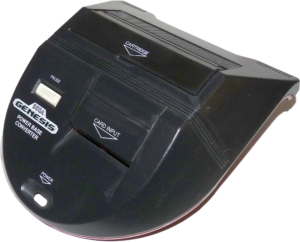
One of the key design features of the Sega Mega Drive console is its backwards compatibility with Sega’s previous console, the Sega Master System. The 16-bit design is based on the 8-bit design, albeit enhanced and extended in many areas. To achieve backwards compatibility, the Master System’s central processor and sound chip (the Zilog Z80 and SN76489, respectively) are included in the Mega Drive. Additionally, the Mega Drive’s Video Display Processor (VDP) is capable of the Master System’s VDP’s mode 4, though it cannot run in modes 0, 1, 2, or 3.
As the cartridge slot is of a different shape, Sega released the Power Base Converter, a separate device that sits between a Master System cartridge and the Mega Drive’s cartridge slot. The Power Base Converter does not contain any Master System hardware components, instead functioning as a pass-through device. The converter contains a top slot for cartridge-based games along with a front slot for card-based games, as well as the 3D glasses adapter. When a Master System game is inserted, the system puts the Z80 in control, leaving the Mega Drive’s main 68000 processor idle. This peripheral was released in Japan on January 26, 1989, for ¥4500 and can only be attached to the original model, making it incompatible with the later second and third revisions of the Mega Drive.
Although the peripheral can play any game within the Master System’s library, one particular game does not work with this device, which is F-16 Fighting Falcon.
Versions
The Sega Mega Drive underwent several design changes and variations throughout its production years, excluding special bundles like the Sega CDX or TeraDrive.
- Mega Drive II (1993):
- Japan, Europe, and Australia[note 3]Spelled as Mega Drive 2 (with an Arabic numeral) in Japan.: Known as the Mega Drive II.
- North America: Marketed simply as Genesis (without the Sega prefix).
- Design Changes:
- Smaller and lighter.
- Removed the headphone jack.
- Replaced the A/V-Out connector with a smaller version that supports stereo sound.
- Simpler and less expensive mainboard requiring less power.
- Genesis CDX/Multi-Mega:
- North America: Known as the Genesis CDX.
- Europe: Marketed as the Multi-Mega.
- Features:
- Combined semi-portable Genesis and Sega CD unit.
- Priced at $399.95, $100 more than the combined cost of individual Genesis and Sega CD units.
- Bundled with Sonic CD, Sega Classics Arcade Collection, and Ecco the Dolphin (Sega CD version).
- Included a small LCD screen displaying the current track when used as a CD player.
- Lightweight, marketed partially as a portable CD player.
- Genesis Nomad:
- Description: Handheld version of the Genesis.
- Design Basis: Modeled after the Mega Jet, a portable Mega Drive unit used on Japanese airplane flights.
- Features:
- Successor to the Game Gear.
- Operates on 6 AA batteries.
- 3.25-inch LCD screen.
- Supports the entire Genesis library, except for one game requiring a reset button, which the Nomad lacks.
- Incompatible with Sega 32X, Sega CD, and Power Base Converter.
- TeraDrive:
- Market: Exclusive to Japan.
- Description: A combined Mega Drive and IBM PC compatible computer.
- Arcade System Boards:
- System C-2, MegaTech, and MegaPlay:
- Based on the Mega Drive.
- Supported approximately 80 games combined.
- System C-2, MegaTech, and MegaPlay:
| Title | Also Known As | Year | Region | Distributor |
|---|---|---|---|---|
| Sega Mega Drive | Model 1 Sega Genesis (NA) Super Gam*Boy (KOR) Super Aladdin Boy (KOR, later) | 1988 | International | Sega Samsung (KOR) |
| Mega Drive II | Model 2 Genesis (NA) Super Aladdin Boy II (KOR) | 1993 | ||
| Mega Drive III | N/A | Brazil | Tectoy | |
| Mega Game II | 1997 | Portugal | Ecofilmes | |
| Genesis 3 | Model 3 | 1998 | United States | Majesco |
| Super Mega Drive 3 | N/A | 2001 | Brazil | Tectoy |
Add-Ons
Main articles: Sega CD and Sega 32X
The Sega Mega Drive, also known as Genesis in North America, had two significant add-ons that extended its lifespan into the 32-bit era: the Sega CD and the Sega 32X. These peripherals allowed the Mega Drive to offer enhanced audio-visual capabilities and more complex games.
Sega CD
- Release Dates:
- Japan: December 12, 1991
- North America: October 15, 1992
- Europe: 1993
- Features:
- High-quality CD-ROM drive (1x speed).
- Enhanced audio and visual capabilities over the standard Mega Drive.
- Added a second, more powerful processor, increased system memory, and hardware-based scaling and rotation.
- Included battery-backed storage RAM for saving high scores, configurations, and game progress.
- Notable Games:
- Sonic the Hedgehog CD: Exclusive debut on the Sega CD.
- Sewer Shark: Pack-in game for the North American market.
- Revised Model:
- Sega CD 2: A smaller, lighter, and cheaper version designed for the Genesis II.
- Market Performance:
- Sold 100,000 units in its first year in Japan.
- Better sales in North America and Europe but eventually lost consumer interest due to the novelty of FMV games wearing off.
- Worldwide sales reached 2.24 million units.
- Discontinuation:
- Officially discontinued in 1996 as Sega shifted focus to the Sega Saturn.
Sega 32X
- Release Date:
- North America: November 12, 1994
- Features:
- Added two 32-bit SuperH-2 processors for enhanced graphics.
- Served as a pass-through for Genesis games, using ROM cartridges.
- Marketed as a “transitional device” between the Genesis and the Saturn.
- Notable Game:
- Knuckles’ Chaotix: Exclusive to the 32X.
- Development and Launch:
- Conceptualized to bridge the gap between the Genesis and the Saturn.
- Sega of America’s research and development team played a significant role in its development.
- Launched at a price comparable to a Genesis console, much cheaper than the Saturn.
- Market Performance:
- High demand at launch but limited supply (only 600,000 units shipped by January 1995).
- Faced challenges convincing third-party developers to create games.
- Public anticipation for the Saturn overshadowed the 32X.
- Discontinuation:
- Officially discontinued in early 1996 to focus on the Saturn.
- Prices dropped significantly to clear inventory.
Sega Mega Jet
The Sega Mega Jet was a handheld version of the Sega Mega Drive designed for use aboard Japan Airlines flights, specifically in first and business class.
Key Features:
- Lack of Screen: The Mega Jet did not have its own display. Instead, it connected to a small armrest monitor available on Japan Airlines flights.
- Power Supply: The cord connecting the Mega Jet to the monitor also supplied power to the device.
- Controller Port: An additional port on the top of the Mega Jet allowed for the connection of a standard Mega Drive controller, enabling two-player gameplay.
Game Availability:
- Preloaded Games: Four games were available on the flights, including Super Monaco GP and Sonic the Hedgehog.
- Cartridge Compatibility: The Mega Jet accepted standard Mega Drive cartridges, allowing passengers to use their own games if they wished.
Market Presence:
- Limited Release: The Mega Jet was marketed in Japan as a portable Mega Drive and was available in limited quantities in department stores.
Legacy:
- Sega Nomad: The Mega Jet served as the basis for the Sega Nomad, a portable Mega Drive with a backlit screen released exclusively in the United States in 1995.
Sega Mega Jet

The Sega Mega Jet.
General Information
Type
Handheld video game console
Manufacturer(s)
Sega
First Available
JP 1 July 1993 (airlines)
JP 10 March 1994 (retail)
Launch Price
¥15000
Technical Information
CPU
- Motorola 68000 7.67MHz (primary)
- Zilog Z80 3.58MHz (secondary)
RAM
- 72kB RAM
- 64kB VRAM
Sound
- Mono speakers
- Yamaha YM2612
- Texas Instruments SN76489
SEGA Nomad
The Sega Nomad, also known as the Sega Genesis Nomad or simply the Nomad, was a portable gaming console released specifically for the North American market. It allowed players to use Sega Mega Drive game cartridges. Unlike its Japanese counterpart, the Sega Mega Jet, which required an external monitor, the Nomad boasted a built-in color screen. During its development, the system was codenamed Project Venus, following Sega’s practice of naming their projects after planets.
Game Library
The Nomad does not come with its own game library; instead, it is designed to play standard Genesis cartridges. At the time of its release, the Genesis had a library of over 500 games. However, the Nomad did not include a pack-in game. It is capable of running unlicensed, homebrew, and bootleg Genesis games.
Some older third-party titles may experience compatibility issues on the Nomad, though these can often be resolved using a Game Genie. Additionally, the Nomad is incompatible with any of the Genesis add-ons, meaning it cannot play games designed for the Sega Master System, Sega CD, or Sega 32X. The Nomad uses both physical and software-based regional lockout methods, but there are known methods to bypass these restrictions.
Sega Nomad
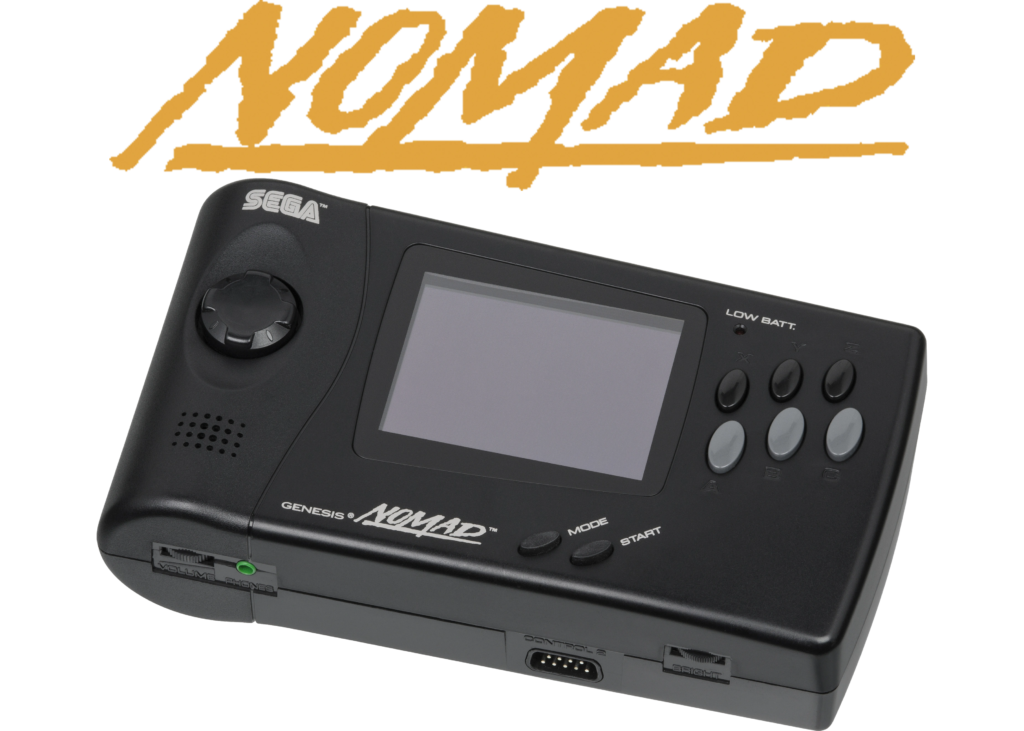
The Sega Nomad.
General Information
Type
Handheld video game console
Manufacturer(s)
- Sega
- Majesco
First Available
USA October 1995
Launch Price
$179
Discontinued
1999
Units Sold
<1 million
Technical Information
CPU
- Motorola 68000 (primary)
- Zilog Z80 (secondary)
RAM
- 72kB RAM
- 64kB VRAM
Sound
- Mono speakers
- Yamaha YM2612
- Texas Instruments SN76489
| Precursor | Successor |
|---|---|
| Sega Game Gear | Dreamcast VMU |
Trivia
- Japanese Mega Drive cartridges have a distinct shape that prevents them from fitting into American Genesis or PAL region Mega Drive cartridge slots. Japanese Mega Drive systems also have a piece of plastic that blocks the cartridge slot when the power is turned on, making it impossible to use a Genesis cartridge. Minor adjustments to the plastic locks inside the consoles can circumvent these regional restrictions.
- The console’s main board features language and frequency jumper settings, initially intended to activate specific ROM features for different regions. Over time, this functionality was repurposed to enforce software-based regional locks, which display warning messages preventing game play. Using switches in place of the jumpers can bypass these locks. For region-locked games with multiple language options, the language can be adjusted using these switches after the game has started.
- Overall, there are more than 900 games available for the Mega Drive/Genesis, spanning seven major regions: Japan, North America, Europe, Australasia, Korea, Asia, and Latin America.
- In Lego Dimensions, Sonic encounters various robotic foes, including Robo Sonic, Mecha Sonic, and Metal Sonic. After defeating them, Metal Sonic’s explosion damages the portal device, causing three portals to open, with the first model of the Sega Mega Drive emerging from one of them.
- In 1991, JAMMA released an arcade board called the Sega Mega Play, which was capable of playing Sega Mega Drive games. This hardware was distributed in Asia and the PAL regions but did not reach North America.
- The Mega Drive was the first console to offer online connectivity via the Mega Modem add-on, which was available exclusively in Japan.
References
- ↑ Gallery (Japanese). Sega. Retrieved on 25 February 2022.
- ↑ Kent, Steven L. (2001). The Ultimate History of Video Games. Roseville, California: Prima Publishing. pp. 404–405. ISBN 0-7615-3643-4.
- ↑ Kent, Steven L. (2001). The Ultimate History of Video Games. Roseville, California: Prima Publishing. pp. 404–405. ISBN 0-7615-3643-4.
- ↑ Tecblogger (17 September 2010). Tectoy History (Portuguese). Tectoy. Archived from the original on 23 March 2012. Retrieved on 26 February 2022.
- ↑ “Letter“. Sega Force Mega: 19. November 1993. Archived from the original. Retrieved on 25 February 2022.
- ↑ Mega Drive 2 (Japanese). Sega. Retrieved on 25 February 2022.
- ↑ Sega Mega Drive/Genesis Console Information. Console Database. Base Media. Retrieved on 4 June 2018.
- ↑ Kent, Steven L. (2001). The Ultimate History of Video Games: The Story Behind the Craze that Touched our Lives and Changed the World. Roseville, California: Prima Publishing. pp. 303, 360. ISBN 0-7615-3643-4.
- ↑ Nintendo Official Magazine Staff (2001). Nintendo Official Magazine – Nintendo’s Market Share 1988. Future Publishing. pp. 35.
- ↑ Business Week staff (1999). Business Week – Nintendo’s Market Share 1990. pp. 60.
- ↑ Brandt, Richard; Gross, Neil (February 21, 1994). “Sega!”. BusinessWeek. Bloomberg L.P. Archived from the original on December 3, 2013. Retrieved October 10, 2013.
External Links
- Sega Mega Drive at Wikipedia, the free encyclopedia
- Sega Nomad at Wikipedia, the free encyclopedia
